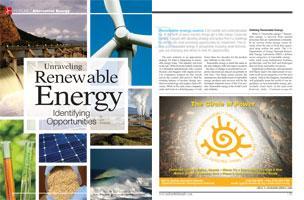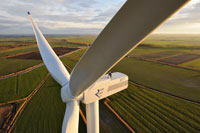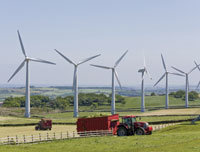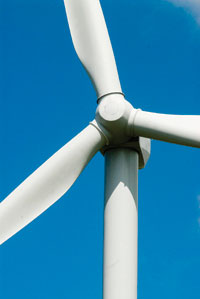
 Renewable energy seems a muddle and understandably so. At the birth of every industry things get a little messy. Corporate leaders charged with deciding strategy and tactics find it a challenge to identify the most promising opportunities for investment. This article puts renewable energy in perspective including what technologies are emerging and where to look for opportunities.
Renewable energy seems a muddle and understandably so. At the birth of every industry things get a little messy. Corporate leaders charged with deciding strategy and tactics find it a challenge to identify the most promising opportunities for investment. This article puts renewable energy in perspective including what technologies are emerging and where to look for opportunities.
The auto industry is an appropriate analogy for what is happening in renewable energy today. This industry was born in the late 1890s from the hybrid creations of a thousand entrepreneurs who crossed bicycles and buggies with engine power. Car companies popped up like weeds across the country and raced to find the winning balance of product design, production technology and supply chain efficiency. While in the early years companies came and went at a dizzying pace, it took fewer than two decades for the modern auto industry to take form.
Renewable energy is much the same as the auto industry with one major exception – the pace of change is accelerated as corporate decisions are played out globally in real time. One thing seems certain, the manufacture and deployment of renewable energy products and services will be the dominant industrial sector of the 21st century. Renewable energy is the world’s next auto industry.
Defining Renewable Energy
 What is “renewable energy”? Renewable energy is derived from natural processes that are replenished constantly. In its various forms energy comes directly from the sun or from heat generated deep within the earth. The U.S. Department of Energy National Renewable Energy Laboratory (NREL) defines seven categories of renewable energy – solar, wind, ocean, hydropower, biomass, geothermal, and bio-fuel and hydrogen derived from renewable resources.
What is “renewable energy”? Renewable energy is derived from natural processes that are replenished constantly. In its various forms energy comes directly from the sun or from heat generated deep within the earth. The U.S. Department of Energy National Renewable Energy Laboratory (NREL) defines seven categories of renewable energy – solar, wind, ocean, hydropower, biomass, geothermal, and bio-fuel and hydrogen derived from renewable resources.Significant technologic advancements will likely lead to the deployment of systems in all seven categories over the next century. And as this happens, humankind will gradually wean the world of our dependence on non-renewable energy, particularly fossil fuels. In the near term however, widespread adoption of renewable energy generation technologies will center on wind and solar with bio-fuels following close behind.
Emerging Technologies
Much is made of the growth potential of a green economy.
 Business leaders are keen to understand where future renewable energy dollars will be spent in
Business leaders are keen to understand where future renewable energy dollars will be spent in
Widespread adoption of a given renewable energy technology is dictated by market forces. If the price of energy is competitive, then a market will develop. Promising research has led to early stage products in ocean, biomass, geothermal, bio-fuel and hydrogen. However, in general these technologies do not currently produce competitively priced energy. As a consequence, investment is not widespread.
A promising technology is in the area of bio-fuels. The on-again, off-again cycles of investment in ethanol production from agricultural feedstock is unlikely to stabilize and consequently will not be part of a long term bio-fuel solution. The real opportunity lies in bio-fuel produced from cellulose, principally forest products and from algae.
While promising algae and cellulose technologies are in the pipeline, technical challenges surrounding production scale-up are holding back full commercialization. Once these gaps are bridged, we can expect to see significant large scale cellulose bio-fuel production in the pine forests of the southern and southeast
The supply chain for manufacturing of bio-fuel production equipment will likely be extensive and geographically dispersed. Low cost manufacturing is a location consideration but access to markets will favor
Solar and Wind Dominate
 Solar and wind will likely see 80 percent all capital expenditures on renewable energy over the next 20 years. Expenditures will be fueled by competitively priced electricity generated from wind and solar. Where renewable energy is not competitive, the desire by consumers to purchase “green” energy, even if it costs more, is also stimulating the market.
Solar and wind will likely see 80 percent all capital expenditures on renewable energy over the next 20 years. Expenditures will be fueled by competitively priced electricity generated from wind and solar. Where renewable energy is not competitive, the desire by consumers to purchase “green” energy, even if it costs more, is also stimulating the market.When it comes to understanding investment opportunities it is important to know that wind and solar sectors follow very different trajectories with regard to value chain and deployment. Today wind energy is competitive in many
Wind’s manufacturing trajectory is more about capacity than new technologies. Advances in wind turbine design are largely relegated to incremental improvements in materials and scale. For example, sophisticated polymer materials are being used to increase the size and durability of blades while reducing weight. Turbine output has yet to plateau. Once an industry standard, 1.5 MW units are being overshadowed by units as large as 6 MW now being deployed.
 At the center of the wind turbine supply chain are large components including turbines (also referred to as nacelles), blades and towers. Feeding these factories are hundreds of raw material and OEM component manufacturers.
At the center of the wind turbine supply chain are large components including turbines (also referred to as nacelles), blades and towers. Feeding these factories are hundreds of raw material and OEM component manufacturers.
Large components are logistically challenging because of size and handling characteristics. Ocean, barge, rail and oversized trucks are commonly used, often in combination, to transport components for installation.
Most wind turbines are installed as wind farms that supply the power grid. Consistent wind speed and proximity to transmission lines with excess capacity guide location decisions. Coastal areas, mountain passes and the
While
Wind turbines are being deployed at a brisk pace. Approximately 1,000 turbines and 1,800 MW of power were installed in the
Locating Wind Products Manufacturing
Some industry strategists argue manufacturing of large wind components should be located in proximity to wind farms in order to avoid transportation difficulties. To-date, global logistic capabilities have met the transport challenge and the oft predicted rush to manufacture turbines, towers and blades in the
 One outcome that seems likely is that manufacturers and service providers will cluster where ever large component manufacturing sets up shop. A good benchmark is
One outcome that seems likely is that manufacturers and service providers will cluster where ever large component manufacturing sets up shop. A good benchmark is
Economic development officials in
Solar’s Unique Path
Recognizing that the long term growth potential for solar outshines wind, economic development organizations representing all areas of
Residential, commercial and industrial rooftop installations, and large scale solar farms will increasingly dot the landscape as the price of solar generated energy continues to fall. In
 Solar is already competitive in some
Solar is already competitive in some
While solar costs decline, the cost of conventional grid electricity is expected to increase an average of 2 percent per year. Part of this increase will stem from regulation of greenhouse gases likely through market-based economic instruments such as a "cap-and-trade" program.
As pricing changes, so will the location of manufacturing plants. Solar modules can be moved easily around the world, a fact that has helped make
With explosive market growth expected over the next five years there is now a rush to enter the North American market by global and domestic producers alike. This will drive profit margins down and force producers to adopt competitive location strategies.
With the
The North American market can support perhaps 12 to 15 solar manufacturing clusters at maturity. This is based on a formula that balances distance to customers, market size, local operating costs, government incentives and tax policies, plant output capacity and competition.
There are currently five emerging manufacturing clusters in
The Era of Renewable Energy The
The
The Obama administration has certainly brought to focus a widely held belief that energy independence for the
As a consequence industry is in the process of unleashing the power of the market. Investment levels in solar and wind and other renewable technologies are at record levels. For those who are prudent in assessing patterns of investment, significant rewards await.
